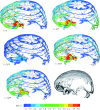Cerebrospinal fluid dynamics in the human cranial subarachnoid space: an overlooked mediator of cerebral disease. I. Computational model
- PMID: 20236960
- PMCID: PMC2894877
- DOI: 10.1098/rsif.2010.0033
Cerebrospinal fluid dynamics in the human cranial subarachnoid space: an overlooked mediator of cerebral disease. I. Computational model
Abstract
Abnormal cerebrospinal fluid (CSF) flow is suspected to be a contributor to the pathogenesis of neurodegenerative diseases such as Alzheimer's through the accumulation of toxic metabolites, and to the malfunction of intracranial pressure regulation, possibly through disruption of neuroendocrine communication. For the understanding of transport processes involved in either, knowledge of in vivo CSF dynamics is important. We present a three-dimensional, transient, subject-specific computational analysis of CSF flow in the human cranial subarachnoid space (SAS) based on in vivo magnetic resonance imaging. We observed large variations in the spatial distribution of flow velocities with a temporal peak of 5 cm s(-1) in the anterior SAS and less than 4 mm s(-1) in the superior part. This could reflect dissimilar flushing requirements of brain areas that may show differences in susceptibility to pathological CSF flow. Our methods can be used to compare the transport of metabolites and neuroendocrine substances in healthy and diseased brains.
Figures






Similar articles
-
Three-dimensional computational modeling of subject-specific cerebrospinal fluid flow in the subarachnoid space.J Biomech Eng. 2009 Feb;131(2):021010. doi: 10.1115/1.3005171. J Biomech Eng. 2009. PMID: 19102569
-
Cerebrospinal fluid dynamics in the human cranial subarachnoid space: an overlooked mediator of cerebral disease. II. In vitro arachnoid outflow model.J R Soc Interface. 2010 Aug 6;7(49):1205-18. doi: 10.1098/rsif.2010.0032. Epub 2010 Mar 24. J R Soc Interface. 2010. PMID: 20335192 Free PMC article.
-
Patient-specific computational fluid dynamic simulation of cerebrospinal fluid flow in the intracranial space.Brain Res. 2022 Sep 1;1790:147962. doi: 10.1016/j.brainres.2022.147962. Epub 2022 Jun 3. Brain Res. 2022. PMID: 35667413
-
Amplitude and phase of cerebrospinal fluid pulsations: experimental studies and review of the literature.J Neurosurg. 2006 May;104(5):810-9. doi: 10.3171/jns.2006.104.5.810. J Neurosurg. 2006. PMID: 16703889 Review.
-
[Hypothesis of cerebrospinal fluid formation and absorption: from the clinical viewpoint of idiopathic normal pressure hydrocephalus].Rinsho Shinkeigaku. 2014;54(12):1190-2. doi: 10.5692/clinicalneurol.54.1190. Rinsho Shinkeigaku. 2014. PMID: 25672742 Review. Japanese.
Cited by
-
Comparison of 4D phase-contrast MRI flow measurements to computational fluid dynamics simulations of cerebrospinal fluid motion in the cervical spine.PLoS One. 2012;7(12):e52284. doi: 10.1371/journal.pone.0052284. Epub 2012 Dec 21. PLoS One. 2012. PMID: 23284970 Free PMC article.
-
Barrier dysfunction or drainage reduction: differentiating causes of CSF protein increase.Fluids Barriers CNS. 2017 May 18;14(1):14. doi: 10.1186/s12987-017-0063-4. Fluids Barriers CNS. 2017. PMID: 28521764 Free PMC article.
-
Ex-vivo quantification of ovine pia arachnoid complex biomechanical properties under uniaxial tension.Fluids Barriers CNS. 2020 Nov 12;17(1):68. doi: 10.1186/s12987-020-00229-w. Fluids Barriers CNS. 2020. PMID: 33183314 Free PMC article.
-
Computational Fluid Dynamics of Cerebrospinal Fluid.Adv Exp Med Biol. 2024;1462:417-434. doi: 10.1007/978-3-031-64892-2_25. Adv Exp Med Biol. 2024. PMID: 39523280 Review.
-
The Development of Non-Invasive Optical Brain Pulse Monitoring: A Review.Med Devices (Auckl). 2024 Dec 11;17:491-511. doi: 10.2147/MDER.S498589. eCollection 2024. Med Devices (Auckl). 2024. PMID: 39678442 Free PMC article. Review.
References
-
- Aroussi A., Zainy M., Vloeberghs M. 2000. Cerebrospinal fluid dynamics in the aqueduct of Sylvius. Int. Symp. Flow Vis. 95, 1–11.
-
- Bloomfield I. G., Johnston I. H., Bilston L. E. 1998. Effects of proteins, blood cells and glucose on the viscosity of cerebrospinal fluid. Paediatr. Neurosurg. 28, 246–251. - PubMed
-
- Brinkman H. C. 1948. On the permeability of media consisting of closely packed porous particles. Appl. Sci. Res. Sect. A Mech. Heat Chem. Eng. Math. Methods 1, 81–86.
Publication types
MeSH terms
LinkOut - more resources
Full Text Sources
Medical

